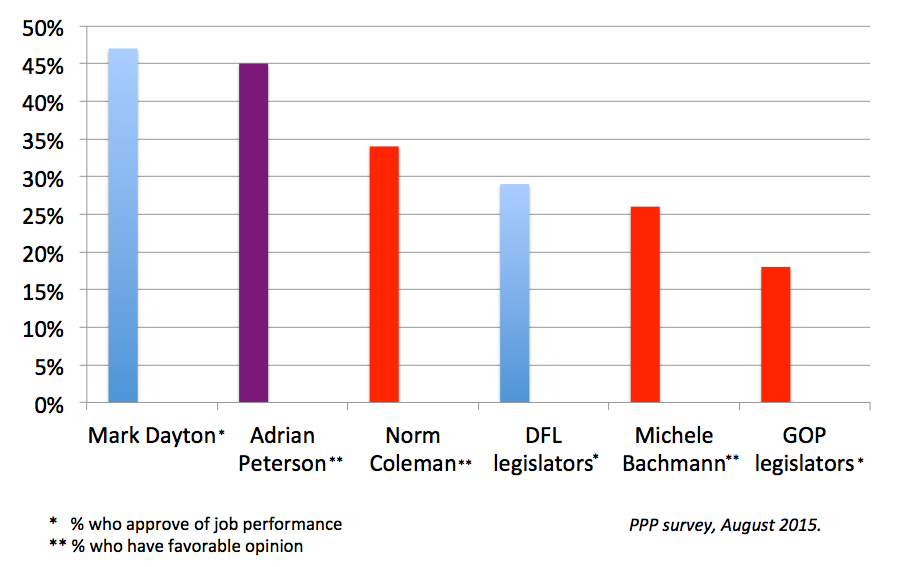
PPP survey, August 2015.


PPP survey, August 2015.
Vikings PR people like to tell Minnesotans that the team’s owner, billionaire Zygi Wilf, is paying about 60 percent of the ever-growing $1.2 billion stadium cost. The truth, as Star Tribune/1500ESPN columnist Patrick Reusse pointed out back in May 2012, is that something like $450 million of the Wilf’s share will be paid by people other than the Wilfs. For instance, season ticket holders will be making exorbitant seat license payments to the Wilfs, the National Football League will be paying a subsidized “loan” to the Wilfs, and U.S. Bank will be making naming rights payments to the Wilfs. All of this will offset the Wilf’s stadium costs by about $450 million.
Taking all of that into consideration, Mr. Wilf looks to be shelling out more in the neighborhood of $250 million of his own money, or 21% of the cost of the $1.2 billion total, not the 60 percent the Vikings claim. It’s difficult for an outsider to come up with precise numbers, but that seems like a pretty fair, pardon the pun, ballpark estimate.
Meanwhile, state and local taxpayers are paying about half a billion dollars for the Vikings’ stadium, or about 40 percent percent of the stadium cost. In other words, taxpayers are paying significantly more than the billionaire owner.
Despite being the majority investor, taxpayers have no say in the name of the stadium, and will be getting 0 percent of the estimated $10 million per year of corporate naming rights payments that U.S. Bank will be paying over the next two decades. The billionaire Wilfs will be getting 100 percent of the $220 million in naming rights payments.

 It’s bad enough that U.S. Bank looks to be getting more corporate visibility than Chairman Mao demanded for himself at Tiananmen Square. To add insult to aesthetic injury, taxpayers aren’t getting a single penny for putting up with U.S. Bank’s excessive corporate graffiti.
It’s bad enough that U.S. Bank looks to be getting more corporate visibility than Chairman Mao demanded for himself at Tiananmen Square. To add insult to aesthetic injury, taxpayers aren’t getting a single penny for putting up with U.S. Bank’s excessive corporate graffiti.
And so ladies and gentlemen, I give you U.S. Bank Stadium, formerly billed to skeptical taxpayers as the “people’s stadium.” State leaders should be doing some retrospective soul-searching about how they got so thoroughly fleeced by the Wilfs on this deal.
These are very heady times for Minnesota DFLers. Governor Mark Dayton and DFL legislators had the courage to raise taxes, increase long-term investments, and raise the minimum wage. In the process, Minnesota Republicans were proven wrong, because the economic sky did not fall as they predicted it would. In fact, liberally governed Minnesota, with an unemployment rate of just 3.7 percent, has one of the stronger economies in the nation.
And the subsequent coverage from the liberal echo chamber has been positively intoxicating for DFLers:
“This Billionaire Governor Taxed the Rich and Increased the Minimum Wage — Now, His State’s Economy Is One of the Best in the Country” (Huffington Post)
“The Unnatural: How Mark Dayton Bested Scott Walker—and Became the Most Successful Governor in the Country” (Mother Jones)
“What happens when you tax the rich and raise the minimum wage? Meet one of USA’s best economies” (Daily Kos)
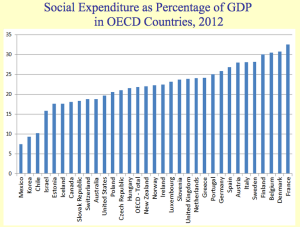 High as a kite from these clippings and the vindication they represent, DFLers run the risk of over-stepping, of pushing Minnesotans further than it they are comfortable going. As much as DFL politicians fantasize about bringing the social welfare model of a Scandinavian nation to a state populated with so many Scandinavian immigrants, a recent survey in the Star Tribune provides a harsh reminder that Minnesota, politically speaking, is not MinneSweden.
High as a kite from these clippings and the vindication they represent, DFLers run the risk of over-stepping, of pushing Minnesotans further than it they are comfortable going. As much as DFL politicians fantasize about bringing the social welfare model of a Scandinavian nation to a state populated with so many Scandinavian immigrants, a recent survey in the Star Tribune provides a harsh reminder that Minnesota, politically speaking, is not MinneSweden.
In the wake of a $2 billion budget surplus, only one out of five (19 percent) Minnesotans wants to “spend most to improve services.” Among the Independent voters that DFLers need to persuade in order to win elections and legislative power, only one out of four (24 percent) supports spending the entire surplus.
At the same time, two times as many Minnesotans support the predictable Republican proposal to “refund most to taxpayers” (38 percent support). Their refund proposal is also the most popular option among the Independent voters that Republicans need to win over in order to have electoral success in 2016.
The Star Tribune also reported that their survey found that Minnesotans are not too wild about the gas tax increase the DFLers propose. A slim majority (52 percent) oppose “Governor Dayton’s proposal to raise the wholesale tax on gasoline to increase spending on road and bridge projects?” A healthier majority (62 percent) of Minnesota’s’s Independents oppose the gas tax increase.
I happen to agree with the DFL on the merits. Minnesota has a lot of hard work to do in order to remain competitive into the future, so I personally support investing almost all of the budget surplus, with a healthy amount for the rainy day fund, and a gas tax increase. However at the same time, I’m enough of a realist to recognize that sustainable progressive change won’t happen if Daily Kos-drunk DFLers overstep and lose the confidence of swing voters in the process.
DFLers who want to win back the trust of a majority of the Minnesota electorate would be wise to enact a mix of sensibly targeted investments, a resilient rainy day fund and targeted tax relief. That kind of pragmatic, balanced approach won’t turn into St. Paul into Stockholm, but it might just put more DFLers in power, so that the DFL can ensure Republicans don’t turn Minnesota into South Dakota or Wisconsin.
 For a lot of years, whenever I thought about standardized tests, I only thought about how much I sucked at them. The difference between my strong grades and my weak standardized test scores was dramatic. My low standardized test scores cost me early academic opportunities, scholarship money and self-confidence.
For a lot of years, whenever I thought about standardized tests, I only thought about how much I sucked at them. The difference between my strong grades and my weak standardized test scores was dramatic. My low standardized test scores cost me early academic opportunities, scholarship money and self-confidence.
But now that I’ve been professionally successful for a few decades, I’ve been thinking about those tests in a different way.
The primary reason I was lousy at standardized tests was that I was always running out of time, and being forced to randomly fill in answers at the last moment. More to the point, I was running out of time was because I couldn’t stop thinking about things unrelated to standardized test problem-solving.
While reading through questions, I’d continually think about all kinds of extraneous things:
Why? What? How? You don’t need to be Stanley Kaplan to understand how this kind of frivolous intellectual meandering hurts standardized test performance. Every moment I was diverting thoughts to those kinds of questions is obviously a moment I wasn’t solving problems.
But I couldn’t stop myself. Today they might say I had inattentive type Attention Deficit Disorder. In those days teachers said I was “dreamy” or “spacey,” and they were correct. I was more successful in the classroom, where time was much less of an issue and different things were evaluated, but my off-topic musing was devastating when it came to tightly timed standardized tests.
Weakness Becomes Strength
But in later years, I’ve had an epiphany of sorts about all of this: It occured to me that the thought processes I was using when I should have been focused on the standardized test is precisely the kind of thought processes that has made me successful on a professional level. I get hired because people say I’m analytical, creative, unconventional, curious about a wide variety of subjects, a persuasive writer, and can put myself into others’ heads.
In other words, if I had been better at the things that made me a poor standardized test taker, I might have stunk at my chosen career.
Ban Standardized Tests?
The realization that standardized tests weren’t entirely correct in their verdict about me doesn’t make me want to ban standard tests. Many poor test takers seem to go there, but I don’t.
A world without standardized tests certainly would have been good for me, but I don’t think it would be good for society collectively. Standardized tests are necessary for holding administrators, teachers and students accountable, and for helping administrators, teachers and students understand specific weaknesses and strengths, so they can use that knowledge to improve. These tests are far from perfect, but relying solely on random anecdotal evidence presented by people with self-interested agendas is much worse.
Last week, Governor Dayton announced that he was recommending a reduction in the number of standardized tests used in the k-12 system, from 21 to 14. I haven’t studied the issue nearly enough to be qualified to judge the specifics of his recommendation. But whatever the optimal number of tests, I am glad that most of the standardized tests that I detest will continue to be used.
We don’t need to do away with standardized tests. What we need is for counselors, teachers and parents to be doing more to help kids understand what test results do and don’t mean. We need lower scorers to understand that, while the ACT, SAT and GRE will close some doors, research indicates that they still can be academically successful.
As scores are being shared, students should be told this broader truth: Lots of people with great test scores struggle mightily in their careers, while lots of people with poor test scores excel. More importantly, students should study why both of those things happen. They should study the role effort, creativity, and passion will play in making their post-standardized test lives. We need to explain the ways in which adults routinely turn their disadvantages into advantages, and how the skills and knowledge evaluated on standardized tests aren’t necessarily the skills and knowledge needed to succeed in many fields.
The problem with standardized tests is not that they exist. They problem is that we do too little to help dazed and confused test takers put their scores into proper perspective. If we were just a little more deliberate and thoughtful about helping students gain a deeper understanding of what their test scores do and don’t mean, we could make this necessary evil slightly less evil.
Note: This post was also republished in MinnPost.
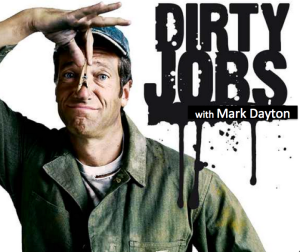 Governor Mark Dayton is Minnesota’s political version of Mike Rowe, the star of the Discovery Channel television show “Dirty Jobs.” Rowe’s show is all about him taking on difficult, disrespected and grotesque jobs that others avoid, such as being a sewer inspector, road kill scavenger, worm dung farmer, shark repellent tester, maggot farmer, and sea lamprey exterminator. Who knew that worm dung needed farming?
Governor Mark Dayton is Minnesota’s political version of Mike Rowe, the star of the Discovery Channel television show “Dirty Jobs.” Rowe’s show is all about him taking on difficult, disrespected and grotesque jobs that others avoid, such as being a sewer inspector, road kill scavenger, worm dung farmer, shark repellent tester, maggot farmer, and sea lamprey exterminator. Who knew that worm dung needed farming?
Dirty Job Dayton
Governor Mark Dayton may not be farming worm dung, but consider just a few of the filthy tasks Dirty Job Dayton has already embraced in his five year’s in office.
Taxing Most Powerful Minnesotans. Before Dayton, non-partisan analyses were showing that the wealthiest Minnesotans were not paying their fair share of taxes. So Dayton ran for Governor unabashedly championing tax increases on the state’s most wealthy citizens, which earned him some very powerful enemies. At the time, progressive political consultants considered advocating almost any kind of tax increase political suicide for candidates. But Dayton ran on a platform of large tax increases, won a razar thin victory at the polls, and then promptly passed the tax increases into law as promised.
Implementing Unpopular Obamacare. Dayton wasn’t done there. One of his very first acts of Governor was to champion Obamacare, which many politicians were extremely nervous about at the time. In contrast to his fellow Governors in neighboring Wisconsin, Iowa and South Dakota, Dayton embraced Obamacare’s Medicare expansion to cover 35,000 of the most vulnerable Minnesotans. The Governor had Obamacare protesters shouting him down in his announcement news conference, but he let them have their say and stuck to his principles without looking back. As a result of taking on a number of controversial Obamacare implementation tasks, Minnesota now has the second best rate of health insurance coverage of any state (95%).
Resolving Vikings Stadium Quagmire. Then there was the Vikings Stadium debate that had been festering for almost a decade before Dayton came to office. Despite polls showing that subsidizing the stadium was unpopular, Dayton provided active backing for legislation to publicly subsidize the Vikings Stadium. While noting that he is “not one to defend the economics of the NFL,” he plugged his nose and embraced a job he didn’t welcome, but felt was necessary to keep the Vikings in Minnesota and boost a then-suffering construction sector.
Cutting Coveted Social Safety Net. Early in Dayton’s tenure as Governor, he even made significant cuts in state safety net programs, which is one of the very worst jobs any progressive can ever get. Faced with a large budget shortfall, he proposed cutting $950 million in planned spending, told agencies to cut their budgets by up to 10 percent, and cut the state workforce by 6 percent. That work had to leave even Dirty Job Dayton feeing grimy.
Love these positions or hate them — and Dayton himself didn’t relish many of them — no one can accuse Dayton of political timidity.
Dirtiest Job Yet
But this winter, Dirty Job Dayton finally met his Waterloo. With no political allies in sight, he attempted to push through salary increases for state agency commissioners, who are making less than their peers in many other states. Dayton said he “knew there would be negative reaction,” but, as is his habit, he plugged his nose and pushed forward anyway.
How did that go for him? Well, in the last few weeks Dayton learned that attempting to raise bureaucrats’ pay makes shark repellent testing look like a walk in the park.
Fresh off that experience, one might expect that Dayton would now stick to clean, safe, and easy jobs for the remainder of his time in office. But if you believe that, you obviously don’t know Dirty Job Dayton very well.
Next Up: Slinging Asphalt
After the salary increase shellacking Dayton endured, he has already found a new thankless task to champion – fixing Minnesota’s deteriorating roads and bridges. While Republicans want a modest short-term fix funded out of the current budget surplus, that would be much too easy for Dirty Job Dayton. Dayton is attempting to put in place an ambitious decade-long $11 billion solution. Such a long-term fix necessitates a 16 cent per gallon (at current prices) increase in the gas tax. Not surprisingly, the polls are looking a little rough at the moment.
But Dirty Job Dayton doesn’t care. Like Mike Rowe, if the assignment stinks, scares, or stings, he’s in!
 One of the things that you can usually expect Republicans to be consistent about is faith in market forces. They’re continually reminding us that we should trust market forces to allocate resources, as opposed to having politicians arbitrarily setting prices and picking winners and losers.
One of the things that you can usually expect Republicans to be consistent about is faith in market forces. They’re continually reminding us that we should trust market forces to allocate resources, as opposed to having politicians arbitrarily setting prices and picking winners and losers.
In the personnel marketplace, this means that if salaries are set below what the rest of the marketplace is bearing, we can expect to attract a smaller pool of talent willing to work at the below-market price. In a market economy, the theory goes, you get what you pay for. If you offer less salary, you attract less talent. If you attract less talent, you get worse personnel. If you get worse personnel, you get incompetent enterprises and poor outcomes.
For Republicans, this trust in markets is a not just any old belief. This really is their core, their bedrock. But it all goes out the window when there is a juicy demagogic opportunity in front of them.
For a politician, the most tempting political opportunity of them all is the chance to get self-righteous about a government pay increase. For demagogues, a government pay increase is as delicious a target as there is. One doesn’t have to be a particularly skilled, bright or courageous politician to score political points this issue. Jihadi John probably could get a standing ovation from Americans if he proclaimed his support for lower government employee salaries.
But again, political opportunism aside, what happened to Republicans’ bedbrock belief in trusting the market price? The Star Tribune has reported on the market price for state government Commissioners and found:
Before smaller raises in 2013 and 2014, agency heads had seen no increase since 2000. A recent analysis by Minnesota Management and Budget showed that before the raises, 14 of 15 commissioners were paid at or below the 50th percentile compared to commissioners in other states; eight were below the 25th percentile. The raises push Minnesota salaries above the median.
Dayton noted in his letter that mid-level managers at many Minnesota companies earn more than his commissioners, who after the increases are earning between $140,000 and $155,000 a year. DHS Commissioner Lucinda Jesson, for instance, manages a $17.7 billion budget and will now make about $155,000.
Dayton also pointed out that even after the raise, the state education commissioner is still earning about 80 percent of the yearly salary of superintendents at a number of larger Minnesota school districts. Education Commissioner Brenda Cassellius had been making $119,000 before the raise. By contrast, the head of Minneapolis schools earns about $190,000.
In other words, senior executives in Minnesota state government had been earning well below the market price being paid peers from other jurisdictions and states. Moreover, I would argue that Commissioners in Minnesota should be paid well above the 50th percentile, since Minnesota is a relatively high income state, ranking 11th highest in the nation.
What do Republicans – stalwart champions for trusting the market to determine prices – think about this market snapshot? The Star Tribune reports:
Republicans scoffed at the argument that Dayton would struggle to attract and retain talented commissioners without the pay increase. Plenty of talented people would serve as Dayton’s commissioners, “at the old price,” said Rep. Greg Davids, R-Preston.
In this case, Republicans effectively are insisting that we ignore the market prices, and instead let politicians set the price and pick winners and losers.
Why the inconsistency? The marketplace argument gets pushed aside in this case for three primary reasons.
First, with legislators earning a ridiculously low salary of $31,140 per year, everything looks extravagant. As I’ve argued before, legislators need a large pay raise to attract a better talent pool, and until they get it, legislators are going to be tempted to pay government employees below what the market is bearing, simply out of jealousy and spite. When they are being paid less than the average sewage worker, I can’t blame them for being bitter, but their own demagoguery is what prevents the problem from getting the problem fixed. In any event, legislators’ low pay is an important undercurrent in this debate.
The second reason market arguments gets ignored by Republicans in this debate is that many honestly have no problem making government less competent. At their core, Repulbicans want government to become smaller. Lower paid commissioners lead to less talented commissioners, which leads to less competent government, which leads to less faith in government, which leads to more political support for shrinking government. Score!
The final reason market arguments get pushed aside by Republicans in this debate is the most obvious. There are cheap political points to be scored. You can bank on the fact that the pay increase will be showing up in endless campaign ads during the 2016 elections. And when you’re only making $31,000 per year, sometimes the adrenalin rush that comes from scoring cheap political points is the best pay available.
– Loveland
Note: This post was featured in MinnPost’s Blog Cabin.
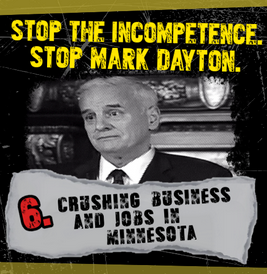 Over the last several years, Minnesota business leaders and conservatives like Tom Emmer and Jeff Johnson have predicted that Governor Dayton’s combination of 1) asking the wealthiest citizens to pay their fair share of taxes, 2) increasing the minimum wage and 3) refusing to enact Pawlenty-style government spending cuts would lead to disaster for the state’s economy. This has been their war cry for years.
Over the last several years, Minnesota business leaders and conservatives like Tom Emmer and Jeff Johnson have predicted that Governor Dayton’s combination of 1) asking the wealthiest citizens to pay their fair share of taxes, 2) increasing the minimum wage and 3) refusing to enact Pawlenty-style government spending cuts would lead to disaster for the state’s economy. This has been their war cry for years.
Minnesota business leaders are now here to tell us that their prediction has proven correct.
Following Dayton’s implementation of those three pillars of Datyonomics, Minnesota currently has a 3.7 percent unemployment rate. Meanwhile, the Twin Cities metropolitan area has a 3.2 percent unemployment rate.
Minnesota’s 3.7 percent unemployment rate compares very favorably to the nation’s 5.8 percent rate. It also looks strong next to the 6.0 percent unemployment rate corporate darling Mitt Romney boasted he could achieve by the end of 2016 if Romnomics polcies were enacted. Conservative Romnomics –tax cuts for the wealthy, no mininum wage increase and massive government spending cuts — essentially would have been the polar opposite of Daytonomics.
While a 3.7 percent unemployment rate in the wake off Daytonomics may look like proof that conservatives and business leaders were incorrect about the destructive impacts of progressive policies, Twin Cities Business reports that Minnesota business leaders disagree. While they acknowledge that high unemployment under Daytonomics would have been bad news for the economy, they now stress that low unemployment under Daytonomics is also bad news for the economy.
“…some business leaders around the state had previously expressed worries about a cooling economy this winter, citing a potential labor shortage as the unemployment rate drops.”
To summarize, if the unemployement rate under the DFL Governor’s progressive policies would have remained at Pawlenty-era peaks (8.3 percent), that would have been proof that Daytonomics was hurting the state economy. But now that unemployment under Dayton policies is low (3.7 percent), that is also evidence that Daytonomics is hurting the economy.
In other words, progressive Daytonomics simply cannot be considered a success. Just ask Minnesota business leaders and conservatives.
– Loveland
Can someone please tell me what Governor Mark Dayton, Al Franken and the DFL Legislature plan to do with another term in office? Because I have no earthly idea.
I know what they have done in the past, and it’s impressive – an improved economy, health care system, and fiscal outlook.
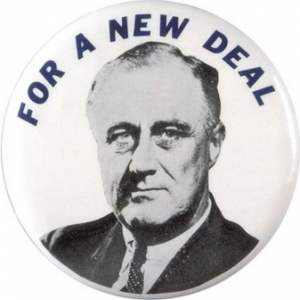 But progressives are also supposed to lead the way forward. The dictionary says a “progressive” is “a person advocating or implementing social reform or new, liberal ideas.”
But progressives are also supposed to lead the way forward. The dictionary says a “progressive” is “a person advocating or implementing social reform or new, liberal ideas.”
Where is the “new” part? Where is the “advocating” part?
It’s entirely possible that I’m not paying close enough attention, because this campaign season is putting me to sleep. But I can’t discern where these top DFLers propose to take Minnesota.
Does the DFL have a “secret plan” for more progress on any of these issues, like the secret plan President Nixon promised to end the Vietman War? If so, why is it secret? I just finished watching the PBS televention series about the Roosevelts, and I was reminded that Teddy, Franklin and Eleanor reaped political rewards by fearlessly advocating for bold solutions to society’s toughest problems.
Again, Minnesota DFLers have earned reelection. They have a strong record of paying back schools, implementing reforms that have a record 95% of Minnesotans with health insurance, improving tax fairness, increasing the minimum wage, passing marriage equality, funding job-creating infrastructure improvements, delivering all-day kindergarten, and balancing the budget on-time, in a fiscally responsible way. That’s very impressive work, at a time when extreme Tea Party-backed Republicans have offered only mindless obstructionism.
But we live in an impatient “what have you done for me lately” world. To prevent an electoral setback a few weeks from now, DFLers need to fire up their progressive base enough to get them to vote at higher rates than they typically do in non-presidential year elections. And in terms of a bold new progressive way forward, Minnesota DFLers haven’t offered much to fire them up.
– Loveland
Note: This post also was also published by MinnPost.
While Minnesota DFLers controlled state government the past two years, they have done some very constructive things:
That’s a very nice body of work for the DFL to showcase to voters. They should be proud of it.
If DFLers lose control of all or some of state government, it likely will have had to do with environmental factors they can’t change , such as low DFL constituency turnout in a non-presidential election and an unpopular Democratic President. Their policymaking performance will not be their biggest political problem.
 But there is at least one policymaking unforced error that is making things a bit more difficult for the DFL — the DFLers authorization of a new Senate office building.
But there is at least one policymaking unforced error that is making things a bit more difficult for the DFL — the DFLers authorization of a new Senate office building.
The new Senate office building project is nowhere near as wasteful as Republicans claim. It also is nowhere near as necessary as Senate DFLers claim. But one thing is indisputable: The political optics of the project are bad for the DFL during the election season.
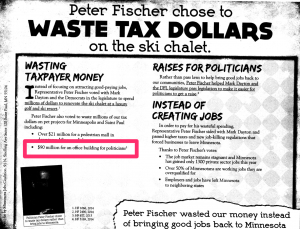 Most voters won’t do a comprehensive financial analysis of whether DFL leaders are doing a good job stewarding their tax dollars. They will judge fiscal stewardship based on an isolated example or two. Republicans are working overtime to make sure that the Senate Office Building is the example voters use to make their judgement.
Most voters won’t do a comprehensive financial analysis of whether DFL leaders are doing a good job stewarding their tax dollars. They will judge fiscal stewardship based on an isolated example or two. Republicans are working overtime to make sure that the Senate Office Building is the example voters use to make their judgement.
The Senate office building works well for the GOP on a political level. First, the building is built for legislators by legislators. On its face, that seems self-serving and arrogant to many voters. Minnesotans don’t take kindly to self-serving and arrogant.
Second, this is not a pole building, and therefore can be made to seem extravagant. The building renderings strike me as modest, responsible and utilitarian, but demagogues are making the Senate office building seem like something akin to Emperor Nero’s Domus Aurea.
The issue is obviously being overblown by Republicans. This project represents only a small fraction of the entire state budget, and the argument for the building is strong, if you actually take the time to study and consider it. But at-a-glance, voters perceive the building to be self-serving and extravagant, and Republicans realize most will voters only consider the issue at-a-glance.
In what is likely to be a close non-presidential election with little room for error, the DFL legislators can’t afford many unforced errors. Choosing this year to build the new Senate office building is one very big unforced political error.
– Loveland
You can’t simultaneously support deism and atheism, or capitalism and communism. Embracing one makes it logically impossible to simultaneously embrace the other. They are mutually exclusive. If a candidate came out and claimed to be for both of those ideological constructs at the same time, in an attempt to win support from supporters of each idea, they would be the laughing stock of American politics.
If you doubt that, imagine if you saw these headlines in today’s news:
Dayton Tells Congregation “I Support Atheistic Christianity”
McFadden Tells Business Group He Embraces “Capitalistic Communism”
The candidates would be laughed out of the race for taking such absurd positions.
I submit that the same should be true of simultaneously advocating to 1) outlaw denial of health coverage due to a pre-existing health condition and 2) make health insurance coverage optional. It’s defensible to embrace either of those two positions. But it’s not defensible to embrace those two approaches simultaneously.
Here’s why: If you outlaw the insurance companies’ enormously unpopular ability to deny coverage due to pre-existing conditions, but simultaneously make purchasing health insurance optional, millions of people would stay out of the insurance market until the moment they got sick or hurt. After all, why would anyone choose to pay high premiums for years to protect themselves against the expenses associated with treating an illness or injury when they know that the insurance company will be forced to pay the treatment expenses after they suffer from the ailment? And if millions of people refused to pay premiums until the moment they need insurance benefits, the insurance industry would very quickly need to dramatically jack up premiums, or go bankrupt.
There is broad consensus about this. The Georgetown University Center on Health Insurance, the Manhattan Institute, America’s Health Insurance Plans (AHIP), the Pacific Research Institute, the Manhattan Institute, The Concord Coalition, the Center on Budget and Policy Priorities, Families USA and many others have all said that a coverage mandate and preexisting condition reform have to be paired in order for the finances of health reform to work.
 Yet when GOP politicians endorse those two mutually exclusive positions, almost no political reporters note the absurdity of it. When reporters allow politicians to get away with simultaneously endorsing the part of Obamacare that outlaws pre-existing condition denials and opposing the part of Obamacare that mandates insurance coverage, they effectively allow those politicians to say something every bit as absurd as “I’m for capitalism, but I also support communism.”
Yet when GOP politicians endorse those two mutually exclusive positions, almost no political reporters note the absurdity of it. When reporters allow politicians to get away with simultaneously endorsing the part of Obamacare that outlaws pre-existing condition denials and opposing the part of Obamacare that mandates insurance coverage, they effectively allow those politicians to say something every bit as absurd as “I’m for capitalism, but I also support communism.”
For example Minnesota U.S. Senate candidate, and millionaire investment banker, Mike McFadden (R-Sunfish Lake) says:
Before we can make the kind of changes Americans deserve, we need to repeal the “Unaffordable Care Act” (which would repeal the coverage mandates)
…when we repeal and replace Obamacare, we need to make sure that those with pre-existing conditions actually have access to affordable insurance plans that cover their illnesses.
Any actuary will tell you that if McFadden and other GOP pols simultaneously enacted those two policies it would lead to a complete and utter meltdown of the nation’s health care finance system. But almost no political reporters will.
– Loveland
Note: This post was also featured on MinnPost’s Blog Cabin.
A new survey released today finds that Minnesota Republican gubernatorial nominee Jeff Johnson now trails incumbent DFL Governor Mark Dayton by just nine points, 39% to 48%. Johnson, a Hennepin County Commissioner, has never won a statewide race before.
 While the findings are a surprise to some veteran political observers, a closer look provides a clue why the relative political newcomer may be showing so strongly. About 78 percent of likely Minnesota voters who say they are supporting Johnson believe that he is either their co-worker (26 percent), neighbor (21 percent), business associate (17 percent), or relative (14 percent).
While the findings are a surprise to some veteran political observers, a closer look provides a clue why the relative political newcomer may be showing so strongly. About 78 percent of likely Minnesota voters who say they are supporting Johnson believe that he is either their co-worker (26 percent), neighbor (21 percent), business associate (17 percent), or relative (14 percent).
According to U.S. Census data, Johnson is the most common surname in Minnesota, surpassing the ubiquitous Andersons, Olsons, Petersons, and Nelsons in Minnesota’s top five.
Asked of 800 likely Minnesota voters, the survey’s margin of error is minus or plus 3.9 percent.
Note: This post is satirical, false, and not-to-believed, but somehow also feels plausible.
 The St. Paul Pioneer Press reported today that Republican gubernatorial candidates have been having daily one up-manship contests over who can have the earliest and nastiest news conference railing about a Dayton-related headline of the day.
The St. Paul Pioneer Press reported today that Republican gubernatorial candidates have been having daily one up-manship contests over who can have the earliest and nastiest news conference railing about a Dayton-related headline of the day.
Minimum wage adjustment! Pant, pant. Sex offenders!! Lather, lather. Medtronic acquisition!!! Podium pound, podium pound.
That’s their savvy strategy — cry “wolf” daily. They read the morning news, race to the podium and rant. In their (bulging) eyes, every Dayton-related development is an outrage, the next “-gate.”
That’s what passes for their policy agenda. That’s the even keel leadership style they are showing voters.
But here is one headline the gunslingin’ gubers won’t be chasing today:
Minnesota adds 10,300 jobs in May; jobless rate lowest in 7 years
Kurt? Jeff? Scott? Marty? Anyone?
– Loveland
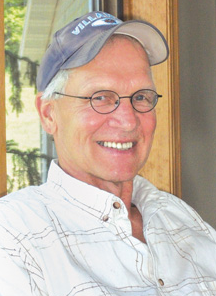 Duane Benson is leading an interesting life. As a football player, he made the unlikely leap from the MIAC’s Hamline Pipers to the NFL’s Oakland Raiders, Atlanta Falcons and Houston Oilers. As a member of what was then called the Independent Republican (IR) Party, he served as Minnesota Senate Minority Leader.
Duane Benson is leading an interesting life. As a football player, he made the unlikely leap from the MIAC’s Hamline Pipers to the NFL’s Oakland Raiders, Atlanta Falcons and Houston Oilers. As a member of what was then called the Independent Republican (IR) Party, he served as Minnesota Senate Minority Leader.
Since retiring from politics, he has served as the Executive Director of the Minnesota Business Partnership, Executive Director of the Minnesota Early Learning Foundation (MELF), Commissioner on the Minnesota Sports Facilities Authority (MSFA) and Trustee of the Minnesota State Colleges and Universities (MnSCU), among other duties. All the while, he has operated a ranch near Lanesboro, Minnesota.
But this has been a particularly poignant time of life for Benson. In the middle of overseeing a massive higher education system and a billion dollar stadium project, Benson’s brother died in a tragic house fire, his beloved dog died, and he was diagnosed with tonsil cancer. He has a lot on his mind.
Benson is a fount of wisdom and humor, so I recently sat down with him over a Grain Belt at O’Gara’s in St. Paul to pick his wry, interesting and mischievous brain.
Q. You recently had surgery for tonsil cancer. How are you feeling these days? A. I’m feeling good. I’m still having a little trouble with excess saliva that effects my speech, but I’m managing that better. I was real lucky early on, and I think my speech is getting better. I still have a little weight to gain back, but I have no complaints.
Q. How did you discover it? A. A dentist said “you have a lump in your jaw.” I went to the family doctor, they took it off. The guy said it’s benign, salivary gland, but I’ll send your stuff over to Mayo. He sent it over there, and they wanted to run a PET scan. They found cancer on my right tonsil. So, they removed the tonsil and the lymph nodes on the right side. You know when you have something like this, you learn of all kinds of people who have had something like this go wrong. They kind of come out of the woodwork. And I can’t think of anyone who has come out of it better than I have. No chemo so far, no radiation, and very little restrictions of anything I do. Yeah, I’ve come out of it well.
Q. The Legislature recently adjourned, and I know you still follow things at the Capitol. How has the tone of legislative discussions changed since you left office? A. Well I think, it’s a little bit like religions for me, organized religions. We have 320 Christian denominations in this country, and that doesn’t count Judaism and Muslims and everyone else. We spend all of our time on how we’re different. Political parties have become that way. We’re spending all our time on how we’re different. To get back to the analogy of religion, a lot of people believe in God, but they spend all their time talking about how they’re different instead of the same. I think the party organization has had a lot to do with manipulating people in politics. I’m encouraged that in recent times Mike Hatch broke the mold and said to his party “I don’t want your endorsement.” Mark Dayton came along and said “I don’t want your endorsement.” In fact, the guy running for Senate (Mike McFadden) said he wouldn’t abide by the party endorsement, which would have been the death knell in the past. And they endorsed him anyway! So I’m encouraged that the whole religion stuff might be dying down. Maybe it’s going back to more about the greater good than “I don’t like you.”
Q. What factors have caused the change in tone? A. I think it’s the focus on how we’re different. I don’t want to harken back to some good old day or something. You should have differences, on four or five really big issues – taxes, could be education delivery, a few others. But now it’s everything. And so I think that partisanship got intensified. But as I said I’m kinda encouraged that I think there’s a little bit of hope that you don’t have to go through the purification process in order to get (on the ballot), which means maybe the greater good will come to the front. When Roger Moe and I were in office, the political parties would come to us as caucus leaders and say “we need money.” We’d write ‘em a check, and say don’t ever darken my door again. Now, political parties come and say “we’ve got the money, and you better be beholden.” That’s very different.
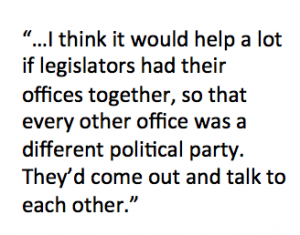 Q. What do you think could be done to improve inter-party legislative relationships? A. It sounds simplistic, but I think it would help a lot if legislators had their offices together, so that every other office was a different political party. They’d come out and talk to each other. Right now for instance with the Senate and that new building, it’s a block from the other side. In the House it’s a floor separating them. And the whole place is run on communications, but I guarantee I can go over there and find people who haven’t met all their colleagues yet. I think office-ing near each other is a kind of a simple fundamental thing that could happen to help people get to know each other. Then I think you start to respect each other, and do all these other things.
Q. What do you think could be done to improve inter-party legislative relationships? A. It sounds simplistic, but I think it would help a lot if legislators had their offices together, so that every other office was a different political party. They’d come out and talk to each other. Right now for instance with the Senate and that new building, it’s a block from the other side. In the House it’s a floor separating them. And the whole place is run on communications, but I guarantee I can go over there and find people who haven’t met all their colleagues yet. I think office-ing near each other is a kind of a simple fundamental thing that could happen to help people get to know each other. Then I think you start to respect each other, and do all these other things.
Q. What else has changed? A. A lot of these ethics laws that needed to be passed did change things. Before, you had to go to these damn (interest group-sponsored) receptions. And you’d go out in front of the Capitol and you’d get in a car, and you didn’t know who in the hell was in it. You know, it would be Democrats and Republicans. You got to know each other. They don’t do that now. None. They’re physically apart. Things got a little overboard ethically in those days, but to some extent there is a chilling effect of going so far in the other direction.
Q. Well, they could grab a beer with each other on their own dime. Do you think that would help? A. Well, sure it would. You know they used to say that Gallivan’s, down on Wabasha in downtown St. Paul, they say most of the laws were written there. (laughing)
Q. How was it working with former Senate Majority Leader Roger Moe? A. I did an interview about Roger Moe and the interviewer said “Roger told me you were the only friend he ever had in the Legislature.” And I said “He was the only friend I had.” They got along pretty good, the bodies, and they didn’t need us. So we had to interject ourselves from time to time. And then Roger was the master of co-opting me and everyone else. He was pretty damn good at it. I’d get our group of people in our caucus all fired up, ‘let’s go get ‘em, it’s an election year.’ They’d look at me and say “Roger appointed me the Chair of some council on seniors, or some damn thing.” (Laughing) Okay, check him off. Before you know it, I’ve got about two supporters left.
Q. You and Senator Moe must have gotten angry at each other during the heat of battle. When that happened, how did you smooth it over so you could move forward? A. I think both of us, if we were wrong, we apologized to each other right away. Or he would be mad, and I’d say “we gotta get this behind us.” So we didn’t let it fester. You know it didn’t hang around and hang around.
Q. Is that because the kind of people each of you are, or is it because that’s what you had to do that to get your jobs done? A. Umm, I don’t know. You know, Roger is a Norwegian. (laughs) The old adage about the Norwegian who loved his wife so much he almost told her, which is kinda true. You know, they don’t say shit. So, we would go to see (DFL) Governor Perpich together. First time. You know, I was so excited, I wanted to know about the squirrels and the windows. Roger doesn’t say a word the whole time. Second time I’m in there. We sat for a half hour. None of us said a word. Walkin’ out and I says to Roger, “That was sure fun.” He says “We actually made a lot of progress.” (laughing) To him, that’s progress. That’s Roger. Wait. Wait. Wait. Wait. Wait.
Q. So, he thought the progress was just that you were establishing a relationship with the Governor? A. Yep. Yep. And the other thing Roger did, and I still use it today, is that he would never sweep the table. Don’t take the crumbs. Given them something. And that year when we had like 41% of the Senators, I set out as our goal to get 41% of everything that went through there. And in the crime bill, we probably got 85%, taxes probably got 40%, health care we got 60%. Roger didn’t sweep the table. (laughing) That’s not the game now.
Q. So why do you suppose he didn’t ‘sweep the table?’ A. He wanted to stay in the majority. He didn’t want to piss anyone off. Boy he was masterful. I couldn’t wake the sleeping giant with a shotgun. He put (the Republican caucus) to sleep.
Q. When you served in the Legislature, which of your colleagues made you laugh the most? A. Oh my God. Clarence Purfeerst. We all have misnomers. You know, I’d keep track of them on paper. And they were subtle. I think I had five pages of them written down. Clarence Purfeerst. He was the Senator from Fairbault. Very effective. He carried the para-mutual betting bill. Living will. Never read ‘em. Never read the bill. Had no idea what was in them. But he’d say “if we could dispense the debate and get to the crotch of the matter.” (Laughs) And he had a hundred of those, and he never knew he said them. And we all said ‘em. Gene Merriam, one of the brightest guys who I ever served with, read every bill, carried the Superfund legislation. Room 15 was just packed. So somebody said, “Senator Merriam, what is pollution.” He says, “well it starts with an orgasm.” (laughs) The place was up for grabs. He turned red. Christ, they couldn’t get control of the place for another 5, 10 minutes. Someone says “you want to try that again?” “Yeah, really what happens with pollution is that it starts with an orgasm.” They adjourned the meeting. (laughs) People would come over to me and ask in a down moment “can I see your list (of misnomers).” Clarence had most of ‘em. But the rest of us, we did alright too.
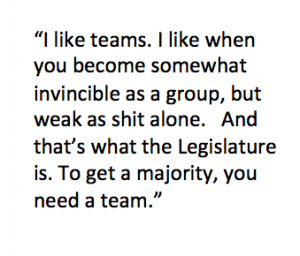 Q. Did it help to get things done, to be able to laugh together? A. Oh I think so. With all that’s happened to me recently with my brother dying, my dog dying, my cancer, and everything else, it kind of gave me a chance to think about what is that I like to do. And I like teams. For whatever reason, I’ve been the captain of everything I’ve played on in sports — in high school, college, the Raiders. It’s because I like teams. I like when you become somewhat invincible as a group, but weak as shit alone. And so, it’s pretty hard not to have an ally if you laugh together. It’s pretty hard to stay mad about something. And that’s what the Legislature is. To get a majority, you need a team.
Q. Did it help to get things done, to be able to laugh together? A. Oh I think so. With all that’s happened to me recently with my brother dying, my dog dying, my cancer, and everything else, it kind of gave me a chance to think about what is that I like to do. And I like teams. For whatever reason, I’ve been the captain of everything I’ve played on in sports — in high school, college, the Raiders. It’s because I like teams. I like when you become somewhat invincible as a group, but weak as shit alone. And so, it’s pretty hard not to have an ally if you laugh together. It’s pretty hard to stay mad about something. And that’s what the Legislature is. To get a majority, you need a team.
Q. So, it’s interesting that you think of both your caucus and the entire Legislature as your team, not just your caucus. Is that right? A. Yeah.
Q. That’s different now? Uh yeah, they had their caucus and we had our caucus. But make no mistake about it, they had more votes than we did. And so to get some of the things that we think are important, with 41% or whatever, (DFL legislators) had to be part of the team. You didn’t have enough votes to cram it down their throats.
Q. What do you think DFLers misunderstand about Republican philosophy? A. I don’t think the electorate is too warmed up to “who did this and who did that.” It’s“how can you fix it?” “Can you make it work?” I would say that what Democrats fail to understand about Republicans is that Republicans want government to work better. Now some of them want less of it, to the point of none of it, but overall they want to fix it.
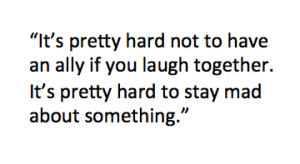 Q. What’s the most important thing your time in football taught you about life? A. (long pause) I think to have fun. Gene Upshaw, Hall of Famer, used to stand up on the table and say “All you f***ers who just want to go out there and think this is fun, you’re not going to get a check. Head out there. Not you Benson, the rest of ‘em.” The game was fun. Politics is fun. I think people who have fun are productive.
Q. What’s the most important thing your time in football taught you about life? A. (long pause) I think to have fun. Gene Upshaw, Hall of Famer, used to stand up on the table and say “All you f***ers who just want to go out there and think this is fun, you’re not going to get a check. Head out there. Not you Benson, the rest of ‘em.” The game was fun. Politics is fun. I think people who have fun are productive.
Q. These days you divide your time between meetings with very powerful people and meetings with cattle and horses out on your ranch. Where do you get more answers? A. More out there (on the ranch). Being alone. I’ve been running for about 55 years. I average about 20 miles per week. Or I’m on a horse. I find myself thinking about goddamnest stuff that I just love. And I don’t have anyone to tell it to. But I don’t give a shit.
Q. Superbowl Sunday 2018. Would you rather be in a luxury suite in the new stadium you are working so hard to oversee as a member of the Stadium Authority, or spending time on the ranch? A. I won’t be at the Super Bowl. Remember the great Duane Thomas from the Dallas Cowboys? He was goofier than hell. He never talked to a reporter all year. Never. So, then they get to the Super Bowl, and none of the reporters are going to talk to him. So, some cub reporter from Davenport or something sticks a mike in front of him. “Oh Mr. Thomas, isn’t this the greatest game ever. Aren’t you so excited. Can you believe this? Isn’t this the greatest game ever?” And he finally talked, first time all year. “No, they’re going to play another one next year.” And that’s kind of how I feel about the Super Bowl. I don’t enjoy watching that much, and that one is going to be so full of hoopla. The game has changed a lot, and I don’t like all of that commotion. Madden called it hoopla.
Q. How has battling cancer changed your outlook on life? A. With my brother’s passing and things that were happening at the same time, you come closer to the realization that nobody gets out of this deal alive. I was thinking “so what is it that you really enjoy.” I’m kind of an isolated, not lonely, but I’m kind of to myself. But I just love the hell out of this team concept stuff. That doesn’t make sense. Kind of an isolationist that liked the team culture, establishing the culture, being part of that. You look at teams and why are some better. It’s the culture. I’m still wrestling with the cancer thing. You know, I’m fully aware that I could go back to the doctor in August and they’d take off a leg or whatever. But either way at some point, the Grim Reaper comes to see you. When I was in a couple training camps, they keep 40 guys and cut 100 guys. Really brutal. (laughing) So in the mornings, you’d hear the kid walking down the hall of the dorm we’re all staying in. “Knock, knock, knock. Breakfast.” “Knock, knock, knock. Breakfast.” “Knock, knock, knock. Breakfast, bring your playbook.” And then you’d hear all the rest of the players holler: “Grim Reaper!” (laughing) Well, that’s one I haven’t finished resolving.
– Loveland
Note: This post was also featured as a “best of the best” in MinnPost’s Blog Cabin.
 A few days ago, I noted an evolution happening with The Yard, the park planned for west of the new Vikings Stadium. In the 2018 Super Bowl bid put together by corporate leaders, images of The Yard were changed from depicting the public playground Minnesotans were initially pitched as part of Governor Dayton’s “People’s Stadium” vision into the more lucrative corporate playground the Vikings’ wealthy owners and their corporate partners covet for Super Bowl soirees.
A few days ago, I noted an evolution happening with The Yard, the park planned for west of the new Vikings Stadium. In the 2018 Super Bowl bid put together by corporate leaders, images of The Yard were changed from depicting the public playground Minnesotans were initially pitched as part of Governor Dayton’s “People’s Stadium” vision into the more lucrative corporate playground the Vikings’ wealthy owners and their corporate partners covet for Super Bowl soirees.
This weekend, a Star Tribune editorial bemoaned the Super Bowl bid committee’s proposal for The Yard:
“The public first glimpsed the Yard as depicted in Ryan’s initial renderings: a lush public expanse of grass and trees framing the city skyline. Even in winter, with snow on the evergreens and skaters on a pond, the Yard was to be the “money shot” that defined our city and state to viewers worldwide, as well as a bustling activity zone for fans on game days and for neighbors and downtown workers on the other 355 days of the year.
But a newer image adds tents of various sizes and exclusive activities for Vikings ticket holders for at least 10 days a year, plus events sponsored by the (Minnesota Sports Facilities Authority) MSFA on part of the park for as many as 40 additional days. During rare mega-events like the Super Bowl or the Final Four, garish tents could cover nearly the entire park space, largely to accommodate national security requirements.”
First, national security officials are obviously capable of securing a small public park on Super Sunday. Maybe skaters would have to walk through metal detectors. Maybe snow fences and security personnel would have to be temporarily used on the perimeter, as is frequently done on the much larger Mall in Washington, DC. Come on Star Tribune, are you really buying the Vikings’ claim that ice skaters are some kind of utterly unmanageable national security risk?
But it gets worse. The Star Tribune then explains that the de-parkification of The Yard goes well beyond Super Sunday.
The upshot is that, yes, the Yard still aims to be both active and attractive, but unfortunately with fewer trees and fewer permanent amenities (public art, fountains, cafes, etc.) than originally imagined, and with more open space for flexible programming, most of it public but some private.
While that doesn’t rule out public skating in winter or soccer and outdoor movies in summer, all of the setting-up and tearing-down of tents and platforms will damage grass and other natural features and, more than that, will consume beauty and time that the public had expected to get.”
So, let me get this straight. The Yard will be exactly like a park, except with few trees, gardens, water features, art or recreational-oriented equipment or structures. Other than lacking those typical park features, and being regularly shut down and ground to a pulp by corporate parties, The Yard will be exactly like all the best urban parks.
The Star Tribune, which will be relocated very close to the Yard, seemed disappointed to learn of the newly marred Yard. But ultimately the editorial staff did what it often does when powerful downtown interests are in play. It pretty much fell in line with the corporate viewpoint.
It’s nearly impossible to accomplish anything big — say, a Vikings stadium in downtown Minneapolis or an adjacent park — without the financial contributions and willing cooperation of various governments, private companies and nonprofit groups, all with competing interests. The result is often a compromise that doesn’t measure up to every expectation.
“Nearly impossible.” So that’s what we’ve come to. Public representatives can no longer create a public park that serves public needs, even after making a half a billion dollar public investment in the development of the area?
The next time you go to Lakewood Cemetery, take a copy of this “nearly impossible” editorial and lay it on the ground. That rumbling you feel is one Charles M. Loring rolling over in his grave.
– Loveland
Democratic Pollster Stan Greenberg thinks one way for Democrats to mitigate their traditional midterm election setbacks is to stump for limits on the influence of big money on politics and policymaking.
In the wake of a couple of unpopular Supreme Court decisions that greatly increased the power of über-wealthy donors in elections, a recent Greenberg poll finds that campaign financing reform is very popular. Greenberg tested support for the Government By The People Act (GBP), which would encourage small in-state contributions by establishing a capped 6-to-1 public financing matching program, and giving a tax credit to small donors.
Among the Democratic base that progressive candidates desperately need to turn out in 2012, this proposal is supported by a nearly 5-to-1 margin. Among the Independent swing voters Democrats need to sway in the 2014 election, it enjoys a 3-to-1 supportive margin.
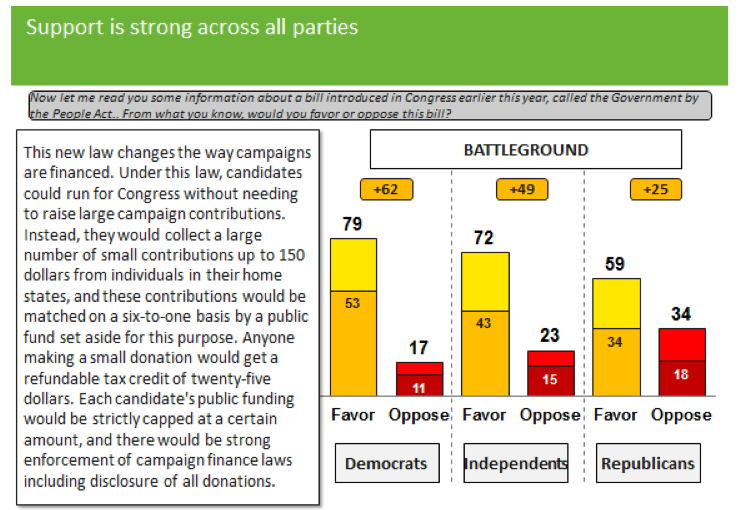 Thanks to Senator John Marty (DFL-Roseville) and others, Minnesota has better campaign financing laws than most states. But Minnesota’s campaign finance system could be improved, and this research shows this is an opportune time to propose improvements.
Thanks to Senator John Marty (DFL-Roseville) and others, Minnesota has better campaign financing laws than most states. But Minnesota’s campaign finance system could be improved, and this research shows this is an opportune time to propose improvements.
It’s too late for DFLers to pass campaign financing law improvements in 2013, but it’s not too late to inject the issue into the 2014 election debate. This would be a great time for Marty to propose GBP-type rewards for small donors, and for DFL candidates to embrace them. It’s the right thing to do substantively, and politically.
– Loveland
 Getting an “annual pay raise” is pretty awesome, especially if you’re a minimum wage worker. Fist pumpingly awesome even. So is getting a pay “bump,” “bonus,” “boost” or “hike.”
Getting an “annual pay raise” is pretty awesome, especially if you’re a minimum wage worker. Fist pumpingly awesome even. So is getting a pay “bump,” “bonus,” “boost” or “hike.”
But having your wage “indexed” for inflation is underwhelming and/or confusing.
When a politician has an opportunity to legitimately claim credit for a guaranteed annual pay raise, that’s political gold. So why are Minnesota DFLers marching around the State Capitol continually yammering to Minnesotans about their desire to “index” the minimum wage? After all, the outcome of indexing is an annual pay raise, unless there is deflation, which is relatively unusual in the United States.
So why not call the DFL’s proposal what ordinary people would call it, an “annual raise?”
“The DFL is fighting to increase the minimum wage increase now, and build-in an annual pay raise for years to come.”
Voters would understand that much better than the current language being used:
“The DFL is fighting to adjust the minimum wage, indexed to the rate of inflation.”
When most minimum wage recipients hear the term “index,” they don’t think “an annual raise.” They think one of two things: 1) Huh? or 2) The part of the book that everyone skips because it’s too boring. Either way, no fist pumps.
Mere wordsmithing, you say? Republicans invest heavily in wordsmithing, and it has proven very effective for them. They hire consultants like Frank Luntz, the author of “Words That Work: It’s Not What You Say, It’s What People Hear,” and many an Orwellian moment. Luntz famously convinced Republicans to shift from “inheritance taxes” to “death taxes.” Luntz understood that “inheritance” sounds unearned and aristocratic to the masses, while “taxing death” sounds outrageously insensitive and unfair. When Republican leaders followed Luntz’s advice, the level of support for inheritance taxes among non-wealthy citizens dramatically decreased.
But that’s not all. Luntz convinced Republicans to march in lockstep from “oil drilling” to “energy exploration,” “health care reform” to “government takeover of health care,” and “corporations” to “job creators.” Luntz showed Republicans that words can work against you or for you. Those seemingly minor shifts have helped Republicans win over many lightly engaged citizens.
So, my fellow liberals, what do you think the great political pied piper Luntz would have to say about Democratic politicians’ love affair with the term “indexing?”
“Indexing” is hardly the Democrats only jargon problem. There is the coded term “single payer” instead of the instantly understandable “Medicare for all.” There is the emphasis on the abstract move to “address the achievement gap” instead of on the more understandable push to “fix failing schools.” There is the sterile push for something called a “sustainable environment” instead of a push for something more tangible and visceral, such as “clean water, land and air.”
Ever-earnest Governor Dayton is trying to fix this through executive order. The Plain Language Fact Sheet that he issued notes, plainly:
Using Plain Language to communicate will: 1) reduce confusion for citizens; 2) save time and resources; 3) improve customer service; and 4) make state government work better for the people it serves.
It will also improve DFLer’s chances in elections. You go, Guv.
Republicans seem to be much more thoughtful and disciplined about campaign communications than Democrats. Republicans will read Luntz’s talking points, and dutifully execute them day after day. “Death tax, death tax, death tax.” Meanwhile, self-serious Democrats turn up their noses about what they regard as superficial “spin,” and cling to their beloved Wonkspeak to impress the think tankers.
Then, come Election Day, the Democrats wonder why voters don’t appreciate their accomplishments. But as I watch the DFL speak in code about “indexing,” I don’t wonder.
– Loveland
Note: This post was featured in Politics in Minnesota’s Best of the Blogs and MinnPost.
 Saint Paul, Minn. — A coalition of Minnesota law enforcement officials announced today that it will push to ban Minnesota patients from using a long list of dangerous prescription pain killers being sold on the streets by criminals.
Saint Paul, Minn. — A coalition of Minnesota law enforcement officials announced today that it will push to ban Minnesota patients from using a long list of dangerous prescription pain killers being sold on the streets by criminals.
At a news conference at the State Capitol today, the Minnesota Law Enforcement Coalition (MLEC) called for legislation to ban codeine, morphine, methadone, fentanyl, oxycodone, hydrocodone, bitartrate, hydromorphone, oxymorphone, meperidine, and propoxyphene. Law enforcement officials stressed that these prescription pain medicines all are dangerous when not used as prescribed, and are currently being sold by criminals on the streets, often to young people.
MLEC has taken the same stand against legislation to make marijuana available to Minnesota patients. Because many seriously ill patients find that marijuana relieves pain and nausea, it has been legalized for medical use in 20 states. But MLEC opposes making marijuana available to Minnesota patients, since it can be harmful when abused, and is being sold illegally on the streets.
“We must do whatever we can to eliminate the abuse and criminal activity associated with these dangerous prescription pain killers,” said Wayne Krupke, Executive Director of MLEC. “For the same reasons marijuana shouldn’t be given to patients, these prescription pain killers shouldn’t be given to patients.”
The advocacy organization Patients for Effective Pain Management (PEPM) maintains that drugs like marijuana, morphine and oxycodone relieve the pain of seriously ill patients, and the good that comes from that outweighs the harm caused by abusers of those drugs.
 “It’s inhumane to deny a proven pain reliever to suffering patients, simply because abuse is possible,” said Mary Ann Wakefield, PEPM’s Executive Director. “Many of the most effective pain meds can be abused or sold on the black market, but that doesn’t mean that we should turn our backs on patients helped by those drugs.”
“It’s inhumane to deny a proven pain reliever to suffering patients, simply because abuse is possible,” said Mary Ann Wakefield, PEPM’s Executive Director. “Many of the most effective pain meds can be abused or sold on the black market, but that doesn’t mean that we should turn our backs on patients helped by those drugs.”
However, Krupke maintains that the medical community has many other pain killers at their disposal, such as aspirin, acupuncture and meditation. At the same time, he points out that the National Institute on Drug Abuse has found that approximately 16 million Americans reported using a prescription drug for nonmedical reasons in 2010.
“As with marijuana, no one can guarantee that drugs like morphine and oxycodone won’t be sold by drug dealers and abused by kids,” said Krupke. “Until and unless they can provide such a guarantee, those pain killers must be outlawed for all, including patients.”
Meanwhile, Governor Mark Dayton pledged to support whatever the law enforcement lobby recommends.
“I will not compromise on this issue unless someone can convince the law enforcement lobby to compromise on it,” said Dayton. “When it comes to what is best for patients in pain, I put my full confidence in the law enforcement lobby.”
Note: This post is satire, and not an actual news story. It was featured in Politics in Minnesota’s Best of the Blogs.
Governor Dayton says he will veto any medical marijuana proposal unless legislators can reach a compromise with law enforcement group lobbyists. The Associated Press reports:
Dayton repeatedly cites law enforcement concerns for his own opposition to medical marijuana. But in an interview today with the Associated Press, the Democratic governor says he’d probably sign a bill to legalize it if sheriffs, prosecutors and other law enforcement groups get behind it.
I support and admire this Governor, so let me say this as politely as I can: Sir, may I please inquire as to WHAT ARE YOU SMOKING?
Governor Dayton, with all due respect, lobbyists were not on our election ballots. You were. Minnesota citizens didn’t give any lobbyists the most powerful tool in a democracy, the veto. We collectively gave it to you, because we can hold you democratically accountable when we disagree with you. We can’t do that with unelected, unaccountable lobbyists.
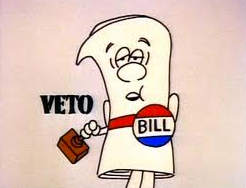 We voted for duly elected lawmakers to compromise with other duly elected lawmakers. The Governor and legislators should certainly be informed by lobbyists on all sides of the issue, but the veto power shouldn’t effectively be handed to lobbyists, as Governor Dayton is doing on the medical marijuana issue.
We voted for duly elected lawmakers to compromise with other duly elected lawmakers. The Governor and legislators should certainly be informed by lobbyists on all sides of the issue, but the veto power shouldn’t effectively be handed to lobbyists, as Governor Dayton is doing on the medical marijuana issue.
Unfortunately, this is not all that uncommon in Minnesota State government. From the left, education reforms too often don’t get a fair debate if the teacher’s union lobbyists turn their mighty thumbs downward. From the right, tax reform has become the impossible dream because a bevy of business lobbyists are effectively given a collective veto.
Too often, legislators aren’t crafting legislative compromises inside legislative hearing rooms and chambers. Instead the compromises are being formulated by the most politically powerful lobbyists in hallways and bars, and are then rubber stamped by legislators eager to please the lobbyists who decide which legislative candidates’ campaign war chests get filled.
I’m not a simplistic lobbyist basher. Lobbyists are here to stay, and that’s actually a very good thing. Though campaign finance laws should limit their influence on the electoral process and less powerful interests need to have better access to lobbyists of their own, I know lobbyists can improve the legislative decision-making process with the specialized information that they bring.
Moreover, I’m not convinced the law enforcement position is all that unreasonable. My understanding is that they could accept a proposal in which the active ingredient in marijuana (THC, Delta-9-Tetrahydrocannabinol) is delivered to patients through pills, oils and vapor. Their concern apparently is with allowing patients to smoke unprocessed leaves, either home grown or commercially grown, because they think having more legal leaves floating around Minnesota would make it more difficult to enforce criminal marijuana laws. Though I support decriminalizing recreational use of marijuana, I am encouraged that law enforcement isn’t saying “never” to these patients. And they certainly have a right to their position.
But they don’t have a right to veto.
So, Governor, please do what we elected you to do. Do the hard work of listening to all sides of the medical marijuana issue, and negotiating with them. At the end of those negotiations, let us know whether YOU believe there is a reasonable policy position, and explain YOUR reasoning for YOUR decisions.
Imagine a man so obsessed with eliminating useless, harmless clutter from his attic that he fails to hear the cry of a suffering relative just a few feet away from him.
Recent news coverage conjures that image for me.
In one part of the news, we have ever-earnest Governor Mark Dayton sorting through the cluttered statutory attic to find useless laws. Downsizin’ Dayton is finding lots of regulatory rubbish, such as a law requiring the capture of wild boars in the Twin Cities. (Don’t worry, legislators, that’s “boars” with an “a.”)
 Elsewhere in the news, we have Minnesotans in severe pain pleading Governor Dayton and legislators for a law to allow them to use medicinal marijuana to relieve severe pain and nausea, as 20 other states already do. To be clear, we’re not talking Cheech or Spicoli here. We’re talking about people suffering and dying.
Elsewhere in the news, we have Minnesotans in severe pain pleading Governor Dayton and legislators for a law to allow them to use medicinal marijuana to relieve severe pain and nausea, as 20 other states already do. To be clear, we’re not talking Cheech or Spicoli here. We’re talking about people suffering and dying.
The Governor is no stranger to pain, and has proven throughout his career to be a very compassionate guy. But for whatever reason, he doesn’t seem to be hearing the cries of these victims. Instead, he’s fixated on getting Boar Laws to the dumpster, and blindly following law enforcement officials who are so obsessed with chasing potheads that they can’t think straight about this very different issue.
Don’t get me wrong. I am not now, nor have I ever been, a Boar Law sympathizer. Like the Governor, I stand steadfastly against the Boar Law, and other forms of legislative hoarding. Moreover, I recognize that some of Dayton’s “Unsession” proposals are very meaty, such as speeding up the environmental permitting process. That’s extremely worthwhile reform work, and I hope the Legislature follows the lead of Governor Dayton and his Un-Lieutenant Tony Sertich.
But let’s face it, much of Dayton’s initiative to eliminate 1,000 laws falls firmly into the category of “nice to have,” rather than “must have.” He is cleaning harmless clutter, and most of us function just fine with harmless clutter in our midst.
Practically speaking, no Minnesotan violating the Boar Law, or similar antiquated laws, is in danger of being busted and imprisoned. But a Minnesotan trying to buy marijuana to ease the pain of a loved one is in very real danger of being busted and imprisoned. That’s bananas.
To the Minnesotans suffering from deadly illnesses, and their loved ones frantic to help them, medical marijuana is much more than a “nice to have.” Former U.S. Surgeon General Jocelyn Elders explains the type of relief that Minnesota lawmakers are denying suffering citizens:
“The evidence is overwhelming that marijuana can relieve certain types of pain, nausea, vomiting and other symptoms caused by such illnesses as multiple sclerosis, cancer and AIDS — or by the harsh drugs sometimes used to treat them. And it can do so with remarkable safety. Indeed, marijuana is less toxic than many of the drugs that physicians prescribe every day.”
“Huh, Surgeon General Elders, did you say something? I can’t hear so well up here in the statutory attic.”
– Loveland
Note: The photo is from Raw Story.
Two recent Star Tribune headlines brought good news and bad news to Minnesota DFLers about their top-of-the-ticket candidates, Governor Mark Dayton and U.S. Senator Al Franken.
Dayton approval rating at its highest
Franken remains a divisive figure
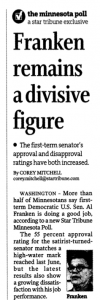 Wow, that must mean that Dayton’s poll numbers are dwarfing poor Al Franken’s, right?
Wow, that must mean that Dayton’s poll numbers are dwarfing poor Al Franken’s, right?
Nope. The actual Minnesota Poll findings told a completely different story than the Star Tribune’s headlines.
A similar number of Minnesotans approved of the jobs Dayton and Franken are doing, 58% and 55% respectively. About the same number of Minnesotans have a favorable attitude of Dayton and Franken, 36% and 38% respectively.
Both DFL candidates are looking relatively strong at this very early stage of the campaign season. Both candidates’ approval ratings are above the 50% mark, which is often considered a key benchmark for incumbents.
Franken’s 55% approval rating would be the envy of many other Democratic Senate incumbents around the nation, such as Alaska Senator Mark Begich (41% approve), Louisiana Senator Mary Landrieu (40% approve), North Carolina Senator Kay Hagan (36% approve), and Arkansas Senator Mark Prior (37% approve). Likewise, Dayton’s 58% approval rating is higher than 19 other gubernatorial incumbents facing races in 2014.
It’s true that Senator Franken has extremely high approval ratings among DFLers (97% approve) and extremely low approval ratings among Republicans(15% approve), hence the “divisive figure” headline. Dayton’s DFL approvers outnumbered his Republican approvers by a massive 4-to-1 margin, but the partisan gap for Dayton was not as large as the partisan gap for Franken.
That kind of large partisan divide is something you see in most political surveys these days. It is a relevant subplot, but its hardly the most important finding to feature in the front page headline.
In the age of information overload, headlines matter, more than ever. Headlines are the only thing that many busy news browsers see. Browsers assume that headlines about a survey feature the most important “bottom line” finding of the survey. The Star Tribune is a very good newspaper, but this was not the Star Tribune at it’s finest.
– Loveland